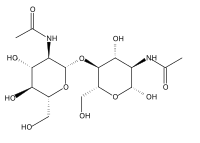

Chitobioses are a group [1] of related disaccharides of β-1,4-linked glucosamine units. The term chitobiose is sometimes used to refer to different members of the group, depending on the method by which it was first isolated, resulting in some ambiguity as to which chemical compound the name is referring to. [2] [3]
Chitobiose is the condensed form of 4‐O‐(2‐amino‐2‐deoxy‐β‐D‐glucopyranosyl)‐2‐amino‐2‐deoxy‐D‐glucose and is an acetylation disaccharide found in chitin. [4] It is formed by the depolymerization of chitin either enzymatically or chemically. [5]
Chitobiose is utilized by Borrelia burgdorferi to produce N-acetylglucosamine, a component of the bacterial cell wall, and is regularized by the response regulator rrp1. A mutant strain of rrp1 has been found to cause growth deficits with Borrelia burgdorferi. [6]
In Escherichia coli, the chb operon is involved with the utilization of cellobiose and β-glucosides chitobiose. The chbG gene of the chb Operon encodes a chitooligosaccharide deacetylase. [7] The chb operon is also responsible for coding the ChbR regulator, which is responsible for activating transcription when chitobiose is available. [8]
- ^ "CHEBI:50674 - chitobioses".
- ^ Bergmann M, Zervas L, Silberkweit E (1931). "Bemerkung zur Arbeit von B. Lange über die spektrale Empfindlichkeit von Sperrschicht-Photozellen". Naturwissenschaften (in German). 19 (28): 20. Bibcode: 1931NW.....19..618B. doi: 10.1007/BF01516360. S2CID 35250905.
- ^ Zechmeister L, Grassmann W, Töth G, Bender R (1932). "Über die Verknüpfungsart der Glucosamin‐Reste im Chitin". Berichte der Deutschen Chemischen Gesellschaft (in German). 65 (10): 1706–1708. doi: 10.1002/cber.19320651016.
- ^ Cammack R (2006). Oxford dictionary of biochemistry and molecular biology (Rev. ed.). Oxford: Oxford University Press. ISBN 978-1-61344-113-8. OCLC 743217704.
- ^ Wu, Xia; Wang, Jing; Shi, Yuqin; Chen, Sai; Yan, Qiaojuan; Jiang, Zhengqiang; Jing, Hao (2017-01-01). "N-Acetyl-chitobiose ameliorates metabolism dysfunction through Erk/p38 MAPK and histone H3 phosphorylation in type 2 diabetes mice". Journal of Functional Foods. 28: 96–105. doi: 10.1016/j.jff.2016.11.012. ISSN 1756-4646.
- ^ Sze CW, Smith A, Choi YH, Yang X, Pal U, Yu A, Li C (May 2013). Camilli A (ed.). "Study of the response regulator Rrp1 reveals its regulatory role in chitobiose utilization and virulence of Borrelia burgdorferi". Infection and Immunity. 81 (5): 1775–87. doi: 10.1128/IAI.00050-13. PMC 3647990. PMID 23478317.
- ^ Verma SC, Mahadevan S (September 2012). "The chbG gene of the chitobiose (chb) operon of Escherichia coli encodes a chitooligosaccharide deacetylase". Journal of Bacteriology. 194 (18): 4959–71. doi: 10.1128/JB.00533-12. PMC 3430350. PMID 22797760.
- ^ Plumbridge, Jacqueline; Pellegrini, Olivier (2004). "Expression of the chitobiose operon of Escherichia coli is regulated by three transcription factors: NagC, ChbR and CAP". Molecular Microbiology. 52 (2): 437–449. doi: 10.1111/j.1365-2958.2004.03986.x. ISSN 1365-2958. PMID 15066032.


Chitobioses are a group [1] of related disaccharides of β-1,4-linked glucosamine units. The term chitobiose is sometimes used to refer to different members of the group, depending on the method by which it was first isolated, resulting in some ambiguity as to which chemical compound the name is referring to. [2] [3]
Chitobiose is the condensed form of 4‐O‐(2‐amino‐2‐deoxy‐β‐D‐glucopyranosyl)‐2‐amino‐2‐deoxy‐D‐glucose and is an acetylation disaccharide found in chitin. [4] It is formed by the depolymerization of chitin either enzymatically or chemically. [5]
Chitobiose is utilized by Borrelia burgdorferi to produce N-acetylglucosamine, a component of the bacterial cell wall, and is regularized by the response regulator rrp1. A mutant strain of rrp1 has been found to cause growth deficits with Borrelia burgdorferi. [6]
In Escherichia coli, the chb operon is involved with the utilization of cellobiose and β-glucosides chitobiose. The chbG gene of the chb Operon encodes a chitooligosaccharide deacetylase. [7] The chb operon is also responsible for coding the ChbR regulator, which is responsible for activating transcription when chitobiose is available. [8]
- ^ "CHEBI:50674 - chitobioses".
- ^ Bergmann M, Zervas L, Silberkweit E (1931). "Bemerkung zur Arbeit von B. Lange über die spektrale Empfindlichkeit von Sperrschicht-Photozellen". Naturwissenschaften (in German). 19 (28): 20. Bibcode: 1931NW.....19..618B. doi: 10.1007/BF01516360. S2CID 35250905.
- ^ Zechmeister L, Grassmann W, Töth G, Bender R (1932). "Über die Verknüpfungsart der Glucosamin‐Reste im Chitin". Berichte der Deutschen Chemischen Gesellschaft (in German). 65 (10): 1706–1708. doi: 10.1002/cber.19320651016.
- ^ Cammack R (2006). Oxford dictionary of biochemistry and molecular biology (Rev. ed.). Oxford: Oxford University Press. ISBN 978-1-61344-113-8. OCLC 743217704.
- ^ Wu, Xia; Wang, Jing; Shi, Yuqin; Chen, Sai; Yan, Qiaojuan; Jiang, Zhengqiang; Jing, Hao (2017-01-01). "N-Acetyl-chitobiose ameliorates metabolism dysfunction through Erk/p38 MAPK and histone H3 phosphorylation in type 2 diabetes mice". Journal of Functional Foods. 28: 96–105. doi: 10.1016/j.jff.2016.11.012. ISSN 1756-4646.
- ^ Sze CW, Smith A, Choi YH, Yang X, Pal U, Yu A, Li C (May 2013). Camilli A (ed.). "Study of the response regulator Rrp1 reveals its regulatory role in chitobiose utilization and virulence of Borrelia burgdorferi". Infection and Immunity. 81 (5): 1775–87. doi: 10.1128/IAI.00050-13. PMC 3647990. PMID 23478317.
- ^ Verma SC, Mahadevan S (September 2012). "The chbG gene of the chitobiose (chb) operon of Escherichia coli encodes a chitooligosaccharide deacetylase". Journal of Bacteriology. 194 (18): 4959–71. doi: 10.1128/JB.00533-12. PMC 3430350. PMID 22797760.
- ^ Plumbridge, Jacqueline; Pellegrini, Olivier (2004). "Expression of the chitobiose operon of Escherichia coli is regulated by three transcription factors: NagC, ChbR and CAP". Molecular Microbiology. 52 (2): 437–449. doi: 10.1111/j.1365-2958.2004.03986.x. ISSN 1365-2958. PMID 15066032.